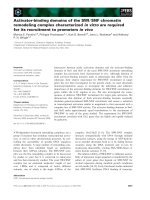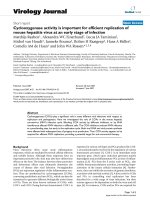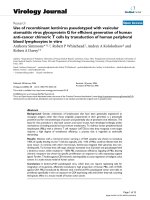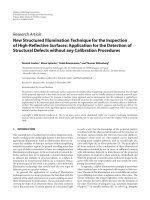High in vitro shoot multiplication for efficient micropropagation of Banana Cv. Robusta (AAA)
Bạn đang xem bản rút gọn của tài liệu. Xem và tải ngay bản đầy đủ của tài liệu tại đây (356.03 KB, 8 trang )
Int.J.Curr.Microbiol.App.Sci (2018) 7(7): 3319-3326
International Journal of Current Microbiology and Applied Sciences
ISSN: 2319-7706 Volume 7 Number 07 (2018)
Journal homepage:
Original Research Article
/>
High in vitro Shoot Multiplication for Efficient Micropropagation of
Banana Cv. Robusta (AAA)
Anita Kumari* and Harsh Kumar
Department of Agricultural Biotechnology and Molecular Biology,
Dr. Rajendra Prasad Central Agricultural University, Pusa, Bihar, India- 848125
*Corresponding author
ABSTRACT
Keywords
Banana, Robusta,
Shoot apices,
Micropropagation,
Subculture cycle
and Multiple shoot
formation
Article Info
Accepted:
24 June 2018
Available Online:
10 July 2018
The cultivar Robusta forms the mainstay of commercial banana cultivation in India. An
efficient micropropagation system with high multiplication rate will boost banana
cultivation and assist banana based industries in the country. The shoot apices of banana
cv. Robusta were cultured on two basal media MS and B5 supplemented with different
concentrations and combinations of plant growth regulators (PGR). The tissue culture
responses were observed for shoot multiplication and effect of subculture on rate of shoot
multiplication till 8th subculture. The maximum frequency of multiple shoot formation
(97.95%) and number of differentiated shoots per culture (27.25) was achieved on medium
M11 (MS+1.14 μM IAA+19.97 μM BAP). The medium was further used for the
multiplication of shoot buds upto eight subculture cycles. The mean number of
differentiated shoots per culture was maintained upto 5 th subculture cycle thereafter
declined in 6th (-16.67%) to 8th (- 40.35%) subcultures. The in vitro developed shoots were
rooted on medium M17 (MS + 4.92 µM IBA). The well rooted plantlets were acclimatized
to field condition.
Introduction
Robusta (AAA) is one of the most important
commercial cultivar of banana grown in AsiaPacific. It is a clone of the dominant Dwarf
Cavendish cultivar and covers majority of the
area under cultivation of banana in India
because of many superior features such as
pleasantly flavoured, attractive colour, pulpy
fruits, exportable large bunches and robust
pseudostem which can withstand strong winds
(Ghosh et al., 2009). It is popular with other
names as Poya, Valery or Tall Mons Mari in
other countries (Simmonds, 1982). Robusta is
the main cultivar grown in Koshi region of
Bihar.
Cultivar Robusta is conventionally propagated
through suckers with low multiplication rate.
The propagules carry pest and pathogen and
the resultant plants require longer period for
flowering and fruiting. Micropropagation
helps in overcoming the problems of
conventional
propagation
and
allows
regeneration of large population of disease
free quality plants in a short period of time for
3319
Int.J.Curr.Microbiol.App.Sci (2018) 7(7): 3319-3326
planting
in
new
areas.
Further,
micropropagated plants are healthier, early
maturing and bear longer bunch with larger
fruits in higher numbers.
There is lack of a proficient micropropagation
system utilizing shoot apices in the cv.
Robusta. There are few reports with low
multiplication rates (Vani and Reddy, 1999;
Senthilkumar
and
Ramsundar,
2009;
Choudhary et al., 2014). Thus, the objective of
the work is to develop an efficient dexterous
microproapagtion system for cv. Robusta to
enhance production of quality propagules with
less time and effort.
Materials and Methods
Collection of disease free healthy sword
suckers of banana cv. Robusta was done from
the experimental field of the Department of
Horticulture, Dr. Rajendra Prasad Central
Agricultural University, Pusa, Bihar, India.
The collected explants were then prepared and
pretreated as suggested by Kumari and Kumar
(2016). The prepared explants were brought to
laminar air flow after washing with distilled
water. A solution of 0.2% HgCl2 was applied
to the explants for their surface sterilization.
The traces of HgCl2 solution was removed by
three consecutive washing of the explants with
sterile distilled water.
The prepared explants were further trimmed to
a size of 0.5 cm3 cube containing apical
meristem and inoculated individually onto the
selected medium, which consisted of MS and
B5 basal media supplemented with different
concentrations and combinations of plant
growth regulators (Auxins- 2,4-D, IAA and
IBA; and Cytokinins- BAP, KIN and TDZ)
(Table 1) (Figure 1A). The cultures were
incubated in culture room at an ambient
temperature of 25 ± 2°C, with continuous
fluorescent light of about 2 kilo lux intensity
and relative humidity (RH) 50 to 80 %.
The differentiated multiple shoots were
routinely subcultured after 6th week for further
proliferation, multiplication and maintenance.
They were divided into groups of 3-5 shoots
and inoculated into individual culture bottles.
After sufficient propagule multiplication,
preferably in sixth subculture, the proliferated
healthier differentiated shoots were further
divided into single shoots and inoculated into
rooting medium for development of roots to
acquire a complete plantlet. The well
developed tissue cultured plantlets having
healthy shoot and roots were selected for
acclimatization. The banana plantlets were
removed cautiously from culture bottles. The
adhered medium from the roots of the
plantlets were gently removed by washing
with a soft brush and transferred to a mixture
of sterilized sand and compost (1:1)
individually in plastic pots. The plantlets were
initially kept under high humid conditions in
an acclimatization chamber for primary
acclimatization in progressive way for 30
days. The primary acclimatized plantlets of
banana were then transferred to green house
for secondary acclimatization. Acclimatized
banana plantlets were subsequently transferred
to field.
The in vitro responses were observed and
recorded at progressive stages. The
experiments were set up in a completely
randomized design (CRD) with a minimum of
30 cultures per treatment. All the data were
analyzed in CRD by executing one factor
analysis of variance (ANOVA) using OP Stat.
The means were compared using Duncan’s
multiple range test (Duncan, 1955) to find the
difference at 5% (P<0.05) level. The results
were expressed as mean ± SE of four
replications.
Results and Discussion
The multiple shoot differentiation from the
cultured shoot apices of banana cv. Robusta
3320
Int.J.Curr.Microbiol.App.Sci (2018) 7(7): 3319-3326
was observed after twenty to thirty days of
culture. New multiple shoot buds were
observed proliferating form the basal margin
of the cultured explant (Figure 1B). The extent
of shoot multiplication was evaluated on the
basis of the frequency and the number of
differentiated shoots per culture. The
frequency of multiple shoot formation ranged
from 26.43 to 97.95% and the number of
differentiated shoots per culture from 7.25 to
27.25. The best multiple shoot formation of
97.95% was observed on the medium M11
(MS+1.14 μM IAA+19.97 μM BAP) which
was at par to 95.71% on medium M14 (B5 +
1.14 μM IAA+ 19.97 μM BAP). The medium
M4 (MS + 22.19 µM BAP) showed the next
best frequency of shoot proliferation
(93.59%). The culture on medium M11
resulted in the highest number of
differentiated shoots per culture (27.25) which
was at par to medium M14 (25.50) and closely
followed by medium M4 (23.25). The other
media M3 (MS + 17.75 µM BAP) and M5
(MS + 23.23 µM KIN) also resulted in good
multiple shoot formation (Table 1). Whereas,
the media M6 (MS + 4.54 µM TDZ) and M7
(MS + 9.08 µM TDZ) were at par for the
induction of low shoot multiplication.
The multiplied shoots on medium M11 were
further subcultured to increase the total
number of in vitro developed shoots onto the
same medium (Figure 1C). The multiple shoot
formation frequency from subcultured in vitro
develop shoots was not affected by the
number of culture cycles generally and
remained cent-percent. However, number of
differentiated multiple shoots per subculture
varied with the increasing culture cycles. The
mean number of differentiated shoots per
culture was at par till 3rd subculture.
Furthermore, it remained more or less same
upto 5th subculture cycle. The potential of
subcultured propagule multiplication in terms
of number of differentiated shoots per culture
declined by 16.67% in 6th subculture, 28.07%
in 7th subculture and 40.35% in 8th subculture
(Table 2). The differentiated multiple shoots
were divided into single shoots and
subcultured for the proper development of
roots on the medium MS + 4.92 µM IBA
following the work of Kumari and Kumar
(2016) (Figure 1D). The observed root
formation from in vitro developed plantlets
was cent-percent on this medium.
The tissue culture derived plantlets of banana
cv. Robusta comprising well developed roots
and healthy shoot were acclimatized
progressively to natural environment was
apposite in term of establishment to field
conditions, plant growth and morphology in
contrast to ex vitro developed parent plant
(Figures 1 E, F).
Shoot apices although are not readily available
explants due to less sprouting of suckers from
the base of banana in ex vitro conditions, but
they are the best explants to acquire multiple
propagules with less variations in in vitro
conditions. Multiple shoot formation was
supported by the media having moderate to
high concentrations of only cytokinin and low
auxin with high cytokinin. The best multiple
shoot formation and the highest number of
differentiated shoots was observed on medium
M11, which was at par to medium M14. Both
of the media are constituted with low
concentrations of auxin IAA and high
concentrations of cytokinin BAP. The
classical hypothesis of ‘chemical control of
organogenesis’
suggested
that
low
concentrations
of
auxin
with
high
concentrations of cytokinin supported multiple
shoot formation (Skoog and Miller, 1957).
The concentration of auxin in cells determines
the position of quiescent centre (Jiang et al.,
2003). The threshold concentration of auxin in
the nucleus resulted in degradation of
AUX/IAA a transcriptional repressor and
subsequent activation of transcription of auxin
biosynthesis pathway by dimerization of
ARFs (Auxin response factors) proteins (Taiz
and Zeiger, 2010).
3321
Int.J.Curr.Microbiol.App.Sci (2018) 7(7): 3319-3326
Table.1 The effect of different media on percentage multiple shoot formation and number of
differentiated shoots per cultured shoot apex of banana cv. Robusta
S. No.
1
2
3
4
5
6
7
8
9
10
11
12
13
14
15
Media
Name
M1
M2
M3
M4
M5
M6
M7
M8
M9
M10
M11
M12
M13
M14
M15
16
M16
Media Compositions
MS + 4.44 µM BAP
MS + 8.88 µM BAP
MS + 17.75 µM BAP
MS + 22.19 µM BAP
MS + 23.23 µM KIN
MS + 4.54 µM TDZ
MS + 9.08 µM TDZ
MS + 9.05 µM 2,4-D + 19.97 µM BAP
MS + 9.05 µM 2,4-D + 18.59 µM KIN
MS + 0.2 µM IAA + 4.5 µM BAP
MS + 1.14 µM IAA + 19.97 µM BAP
B5 + 4.44 µM BAP
B5 + 8.88 µM BAP
B5 + 1.14 µM IAA + 19.97 µM BAP
MS + 4.65 µM KIN + 6.65 µM BAP + 10mg
Bavistin
Modified MS2* + 1.14 µM IAA + 19.97 µM BAP
Mean
SE(m)
CD
CV
Multiple shoot formation
% (mean ± SE)
62.02e ± 1.52
63.04e ± 1.34
72.46c ± 0.67
93.59b ± 1.44
71.28cd ± 0.67
26.43 ± 1.83
33.88 ± 0.94
42.29f ± 0.84
43.74f ± 2.55
67.27d ± 2.85
97.95a ± 1.19
40.34f ± 0.91
62.40e ± 1.08
95.71ab ± 0.22
73.16c ± 2.30
No. of
shoot/explants
14.00cd ± 0.41
16.50bc ± 0.50
17.25b ± 0.85
23.25 ± 0.48
16.50bc ± 0.64
7.25f ± 0.48
8.25f ± 0.48
12.00d ± 0.91
10.00e ± 0.71
12.75d ± 0.85
27.25a ± 0.48
11.25de ± 0.48
15.25c ± 0.85
25.50a ± 0.64
18.25b ± 0.63
82.54 ± 0.91
64.26
1.51
4.29
4.68
21.00 ± 0.91
16.02
0.67
1.91
8.35
Each medium was supplemented with 3% sucrose as carbon source and solidified with 0.8% agar. *Modified MS2 (without NH 4.NO3, KNO32020 mg/l, and decreased concentration of CaCl2.2H2O- 220.50 mg/l, KH2.PO4 – 44 mg/l and H3BO3 – 1.25 mg/l).
Values expressed as mean ± SE. Mean value (n=4) in columns bearing same letter are not significantly different using Duncan’s Multiple Range
Test at 5% level.
Figure.1 A: The cultured shoot apex; B: Differentiated shoots on medium M 11 (MS + 1.14 µM IAA +
19.97 µM BAP); C: Multiplication of shoots after subculture on medium M 11; D: Rhizogenesis from in
vitro developed shoot on medium MS + 4.92 µM IBA; E: Acclimatization of plantlets and F: Pot transfer
of acclimatized plant.
A
B
D
E
C
F
3322
Int.J.Curr.Microbiol.App.Sci (2018) 7(7): 3319-3326
Table.2 The effect of subculture cycle on number of shoot differentiation per culture
S. No.
Media
Number of multiple
shoots/subculture
1
2
3
4
5
6
7
8
Sub1
Sub2
Sub3
Sub4
Sub5
Sub6
Sub7
Sub8
Mean
SE(m)
CD
CV
28.50a ± 0.64
28.75a ± 0.48
27.25ab ± 0.48
26.75b ± 0.48
26.75b ± 0.63
23.75 ± 0.85
20.50 ± 0.64
17.00 ± 0.71
24.91
0.63
1.84
5.04
Percentage change in
number of multiple
shoots/subculture
0
+ 0.88
- 4.39
- 6.14
- 6.14
- 16.67
- 28.07
- 40.35
Values expressed as mean ± SE. Mean value (n=4) in columns bearing same letter are not significantly different using Duncan’s Multiple
Range Test at 5% level.
Cytokinin codes for the repressor protein
AUX/IAA, which in turn inhibits the
biosynthesis of auxin in cells (Dello Ioio et
al., 2008). An optimal concentration of plant
growth hormone cytokinin in medium helps
in cell division and multiplication.
Supplementation
of
auxin
in
low
concentration exogenously in medium with
high concentration of cytokinin helps plant
(explants or shoot apices) to maintain a level
of the hormone which is necessary for the
maintenance of undifferentiated SAM
descendents in cell. These hormonal signals
lend a hand to distinct genes and gene
combinations as SCARECROW (SCR) and
SHORT-ROOT (SHR) to specify root and
shoot meristem formation (Gilbert, 2010),
which in turn enhances the shoot
differentiation.
The media M11 and M14 which resulted in
the highest frequency and number of
differentiated shoots per culture had lower
auxin and higher cytokinin concentrations.
Similar results of the maximum shoot
differentiation from the cultured shoot apices
of different cultivars of banana on media with
similar proportion of auxin and cytokinin was
observed by Iqbal, et al., (2013) and Ahmed,
et al., (2014). However, Iqbal et al., (2013)
utilized the medium MS + 22.2 µM BAP and
8.56 µM IAA with higher concentrations of
same auxin and cytokinin along with 10%
coconut water for shoot multiplication from
shoot tip culture of cv. Williams. Ahmed, et
al., (2014) used medium (MS + 17.75 µM
BAP + 11.42 µM IAA) with low
concentration
of
BAP
but
higher
concentration of IAA compared to present
work for development of adventitious shoots
from shoot tip culture of cv. Grand Naine.
Both the workers worked on autotriploid
(AAA) cultivars of banana like cv. Robusta of
present study. Choudhary, et al., (2014)
reported the maximum 15.6 numbers of
shoots per culture on MS medium with 2.0
mg/1 BAP and 0.5 mg/1 NAA, and 9.7 per
culture on MS medium supplemented with 30
mg/l adenine sulphate, 2 mg/l BAP and 0.5
mg/l NAA from the same cv. Robusta. The
next best medium for multiple shoot
differentiation was M4 (MS + 22.19 µM
BAP). Similarly, Arinaitwe, et al., (2000) got
the best shoot proliferation on higher
3323
Int.J.Curr.Microbiol.App.Sci (2018) 7(7): 3319-3326
concentration of only BAP (28.8 µM). They
showed that BAP was the best cytokinin for
shoot proliferation but the shoot proliferation
rate of 3.5 and 8.0 per culture in two cultivars
Kibuzi and Bwara respectively with same
genome as of cv. Robusta was much less than
observed in the present work.
The impact of media M6 (MS + 4.54 µM
TDZ) and M7 (MS + 9.08 µM TDZ) on
induction of shoot multiplication were at par.
TDZ is a diphenyl urea derived N-phenyl-N’1,2,3-thiadiazol-5-ylurea resistant to all
cytokinin oxidases and induces the
accumulation of endogenous cytokinins
(Kaminek, 1992). Arinaitwe, et al., (2000)
studied the effect of TDZ for the first time on
proliferation rate in Musa spp. They observed
that the proliferation rates of cvs. Bwara and
Kibuzi
increased
with
increasing
concentrations of TDZ (0.045 µM to1.14 µM)
in media and afterwards decreased with
increased concentrations of TDZ (6.81 µM) as
found in the present work. Lee (2005) also
reported that lower concentration of TDZ (0.2
mg/l) was more effective than higher
concentrations. Similar result of multiple
shoot formation response on TDZ was
reported by Kumari and Kumar (2016).
The scope of an efficient micropropagation
system is to achieve a very high propagule
multiplication rate. The shoot apices culture
of banana cultivar Robusta resulted in
establishment of high rate of multiplication of
shoots on medium M11. The frequency of
multiple shoot differentiation was not affected
generally, but the number of differentiated
multiple shoots per subcultured in vitro
developed shoots varied with the increasing
culture cycles. The mean number of
differentiated shoots per culture remained
more or less the same upto 5th subculture
cycle and thereafter encumbered with further
subcultures.
Similar
observation
of
subculturing effect on the proliferation rate of
shoot tip culture of banana was reported by
Kumar, et al., (2005) and Kumari and Kumar
(2016). Contrary to present work Kumar, et
al., (2005) got higher number of differentiated
shoots in 3rd to 5th subcultures.
The stressful environment of plant tissue
culture imposed induction and accumulation
of variation in cultured plant tissues. Multiple
in vitro tissue culture factors induced
variations in plant phenotype, gene expression
and genotypic features. The observed decline
in multiple shoot differentiation efficiency of
subcultured in vitro developed shoots after 5th
subculture might be due to the accumulation
of variations resulting from somaclonal
variations which prevented regeneration of
shoots from variant cells. Similarly,
contribution
of
subculturing
onto
multiplication ability of in vitro developed
shoot buds were recognized by Us-Camas, et
al., (2014) and Saraswathi, et al., (2014).
Aremu, et al., (2013) also reported significant
effect of subculturing onto proliferation and
multiplication potential of banana cv.
‘Williams’ after 6th subculture as found in
present investigation. Many investigators
reported the impact of subculture cycles on
the efficiency of differentiation of multiple
shoots was influenced by the genotype of the
banana cultivars (Abdullah et al., 1997;
Rodrigues et al., 1998).
Development of roots or rhizogenesis is an
important organogenesis without which in
vitro developed shoots may not be converted
in to plants and transplanted to ex vitro
conditions. The in vitro multiplicated plant
propagaules were divided into single shoots
and inoculated onto root inducing medium
consisting of 4.92 µM IBA. Auxin induces
vascular differentiation and plays an
important role in induction and development
of roots (North et al., 2012; Ngomuo et al.,
2014). Indole-3-butyric acid (IBA), a
persuasive plant auxin, was also observed to
produce the greatest number of roots in
present experiment. Similarly, Rahman, et al.,
3324
Int.J.Curr.Microbiol.App.Sci (2018) 7(7): 3319-3326
(2013) and Saraswathi, et al., (2014) reported
its effectiveness in development of roots in
banana cultivars. Manchanda, et al., (2012)
and Kumari and Kumar (2016) obtained
profuse rooting from the base of cultured
shoot of banana cultivars utilizing similar
concentration of IBA (1.0 mg/l). Strosses, et
al., (2004) also subcultured in vitro developed
shoots on the same medium for rhizogenesis
and got cent-percent response during
regeneration of banana plantlets.
The well rooted tissue culture plantlets of cv.
Robusta consisting of healthy shoot were
acclimatized progressively to ex vitro
environmental
conditions
resulted
in
successful establishment of these plants at
fields. Thus, the work resulted in
accomplishment of more efficient and robust
micropropagation system with a high
multiplication rate for the valuable cv.
Robusta as compared to earlier results
(Senthilkumar and Ramsundar, 2009;
Choudhary et al., 2014).
References
Abdullah, K., Khan, IA., Siddiqui, SH., Ahmed,
M. and Siddiqui, KA. 1997. In vitro
culture of indigenous and exotic banana
clones for maximum multiplication.
Pakistan Journal of Botany. 29: 143-50.
Ahmed, S., Sharma, A., Singh, AK., Wall, VK.
and Kumari, P. 2014. In vitro
multiplication of banana (Musa sp.) cv.
Grand Naine. African Journal of
Biotechnology. 13: 2696-2703.
Aremu, AO., Bairu, MW., Szüˇcová, L.,
Doleˇzal, K., Finnie, JF. and Van, Staden,
J. 2013. Genetic fidelity in tissuecultured ‘Williams’ bananas – The effect
of high concentration of topolins and
benzyladenine. Scientia Horticulturae.
161: 324-327.
Arinaitwe, G., Rubaihayo, PR. and Magambo,
MJS. 2000. Proliferation rate effects of
cytokinins on banana (Musa spp.)
cultivars. Scientia Horticulturae. 86: 1321.
Choudhary, D., Kajla, S., Poonia, AK., Duhan,
JS., Kumar, A. and Kharb, P. 2014. An
efficient micropropagation protocol for
Musa paradisiaca cv. Robusta: A
commercial cultivar. Annals of Biology.
30: 25-31.
Dello, Ioio, R., Nakamura, K., Moubayidin, L.,
Perilli, S., Taniguchi, M., Morita, MT.,
Aoyama, T., Costantino, P. and Sabatini,
S. 2008. A genetic framework for the
control of cell division and differentiation
in the root of meristem. Science. 322:
1380-1384.
Duncan, OD. and Duncan, B. 1955. A
methodological analysis of segregation
indexs. American Sociological Review.
20: 210-217.
Ghosh, A., Ganapathi, TR., Nath, P. and Bapat,
VA. 2009. Establishment of embryogenic
cell
suspension
cultures
and
Agrobacterium-mediated transformation
in an important Cavendish banana cv.
Robusta (AAA). Plant Cell Tissue and
Organ Culture. 97: 131-139.
Gilbert, SF. 2010 Developmental Biology. 8th
edition. Sinauer Associates, Inc MA:
Publishers Sunderland. p. 627-653.
Iqbal, MM., Muhammad, A., Hussain, I. and
Bilal, H. 2013. Optimization of in vitro
micropropagation protocol for banana
(Musa Sapientum L.) under different
hormonal concentrations and growth
media.
International
Journal
of
Agricultural Innovation and Research. 2:
23-27.
Jiang, K., Meng, YL. and Feldman, LJ. 2003.
Quiescent center formation in maize
roots is associated with an auxin
regulated
oxidizing
environment.
Development. 130: 1429-1438.
Kaminek, M. 1992. Progress in cytokinin
research. Trends in Biotechnology. 10:
159-162.
Kumar, R., Sinha, K. and Kumar S. 2005.
Micropropagation of banana cv. Malbhog
through meristem tip culture in consort
with thermotherapy. Phytomorphology.
3325
Int.J.Curr.Microbiol.App.Sci (2018) 7(7): 3319-3326
55: 17-22.
Kumari, A. and Kumar, H. 2016. Development
of an efficient micropropagation system
in banana cv. Malbhog (AAB). Advances
in Life Sciences. 5: 3487-3494.
Lee, SW. 2005. Thidiazuron in the
improvement
of
banana
micropropagation. Acta Horticulturae.
692: 67-74.
Manchanda, P., Kaur, A. and Gosal, SS. 2012.
Micropropagation of banana (Musa
acuminata) through proliferation of
axillary shoots. Indian Journal of
Agricultural Sciences, 82: 451-454.
Ngomuo, M., Mneney, E. and Ndakiademi, PA.
2014. The in vitro propagation techniques
for producing banana using shoot tip
cultures. American Journal of Plant
Sciences. 5: 1614-1622.
North, JJ., Ndakidemi, PA. and Laubscher, CP.
2012. Effects of antioxidants, plant
growth regulators and wounding on
phenolic compound excretion during
micropropagation of Strelitzia reginae.
International Journal of Physical
Science.7: 638-646.
Rahman, S., Biswas, N., Hassan, MM., Ahmed,
MG., Mamun, ANK., Islam, MR.,
Moniruzzaman, M. and Haque, ME.
2013. Micropropagation of banana (Musa
sp.) cv. Agnishwar by in vitro shoot tip
culture. International Research Journal
of Biotechnology: 4: 83-88.
Rodrigues, PHV., Tulmann, Neto, A., Cassieri,
Neto, P. and Mendes, BMJ. 1998.
Influence of the number of subcultures on
somoclonal variation in micropropagated
Nanico (Musa spp. AAA group). Acta
Horticulturae. 490: 469-473.
Saraswathi, MS., Praveena, S., Uma, S.,
Thangavelu,
R.,
Kannan,
G.,
Backiyarani, S. and Arivazhagan, T.
2014. Development of an efficient
micropropagation technique for Musa cv.
Udhayam (AAB). Indian Journal of
Horticulture. 71: 452-457.
Senthilkumar, M. and Ramsundar, V. 2009.
Micropropagation of banana Musa spp.
cv. Robusta (AAA). Plant Cell
Biotechnology and Molecular Biology.
10: 1-16.
Simmonds, NW. 1982. Bananas. 2nd edition.
London and New York: Longman. p.
512.
Skoog, F. and Miller, CO. 1957. Chemical
regulation of growth and organ formation
in plant tissues cultured in vitro.
Symposium of Social Experimental
Biology. 11: 118-131.
Strosse, H., Houwe, I. and Panis, B. 2004.
Banana cell and tissue culture review.
Banana improvement cellular molecular
biology
and
induced
mutations.
Proceedings of meeting held in Leuven
Belgium, Belgium, pp. 1-12.
Taiz, L. and Zeiger, E. 2010. Plant Physiology.
5th edition. Sinauer Associates Inc,
U.S.A:
Publishers
Sunderland,
Massachusett. p. 560-562.
Us-Camas, R., Rivera-Solı´s, G., Duarte-Ake,
F. and De-la-Pen˜a, C. 2014. In vitro
culture: an epigenetic challenge for
plants. Plant Cell Tissue and Organ
Culture. 118: 187–201.
Vani, AKS. and Reddy, GM. 1999. Novel
technique in efficient micropropagation
of certain popular banana cultivars.
Journal of Genetics and Plant Breeding.
53: 247-250.
How to cite this article:
Anita Kumari and Harsh Kumar. 2018. High in vitro Shoot Multiplication for Efficient
Micropropagation of Banana Cv. Robusta (AAA). Int.J.Curr.Microbiol.App.Sci. 7(07): 33193326. doi: />
3326









